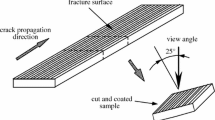Abstract
Single fiber-brittle zone model composites were prepared by the electroless plating method, in order to know the effect of the interfacial bonding strength between the fiber and brittle zone on the fracture strength of the composites. For the case of weak inter-facial bonding, the notch formed by the fracture of the brittle zone at an early stage of deformation was unable to extend into the fiber due to a premature interfacial debonding. Therefore no deleterious effect of the brittle zone on the fiber strength was found. For the case of strong interfacial bonding, the formed notch extended into the fiber, resulting in loss of the fiber strength. The strength of such a composite was well explained by the theory recently proposed by Ochiai and Murakami. The important parameters to describe the fracture behavior of the fiber coated with the brittle zone, the strain energy release rate of the fiber and the permissible thickness of the brittle zone, below which the strength of the fiber is not reduced, were experimentally determined.
Similar content being viewed by others
References
D. W. Petrasek and J. W. Weeton:Trans. TMS-AIME, 1964, vol. 230, p. 977.
P. W. Heitman, L. A. Shepard, and T. H. Courtney:J. Mech. Phys. Solids, 1873, vol. 21, p. 75.
S. Ochiai, K. Shimomura, M. Mizuhara, and Y. Murakami:Trans. Jpn Inst. Met., 1975, vol. 16, p. 463.
A. G. Metcalfe and M. J. Klein:Composite Materials, vol. 1, p. 125, Academic Press, New York and London, 1974.
S. Ochiai and Y. Murakami:J. Mater. Sci., 1979, vol. 14, p. 831.
H. L. Cox:Brit. J. Appl. Phys., 1953, vol. 3, p. 72.
C. Zweben and B. W. Rosen:J. Mech. Phys. Solids, 1970, vol. 18, p. 189.
H. R. Piehler:Trans. TMS-AIME, 1965, vol. 233, p. 12.
K. Nakazawa and S. Umekawa:J. Jpn Inst. Met., 1972, vol. 36, p. 398.
F. O. Jones:Niobium, Tantalum, Molybdenum, and Tungsten, A. G. Quarrel, ed., p. 151, Elsevier, 1961.
D. L. McDanels, R. W. Jech, and J. E. Weeton:Trans. TMS-AIME, 1965, vol. 233, p. 636.
A. Kelly and W. R. Tyson:J. Mech. Phys. Solids, 1965, vol. 13, p. 329.
H. Tada, P. Paris, and G. Irwin:The Stress Analysis of Cracks Handbook, p. 27.1, Del Research Corporation, Hellertown, PA, 1973.
H. Tada, P. Paris, and G. Irwin:ibid, p. 1.12.
Author information
Authors and Affiliations
Rights and permissions
About this article
Cite this article
Ochiai, S., Urakawa, S., Ameyama, K. et al. Experiments on fracture behavior of single fiber-brittle zone model composites. Metall Trans A 11, 525–530 (1980). https://doi.org/10.1007/BF02654576
Received:
Issue Date:
DOI: https://doi.org/10.1007/BF02654576




